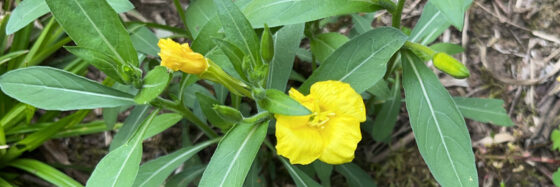
For years I have been working at beating back the aggressive invasive species that have taken over much of my property. I thought of it as gardening by subtraction. Get rid of all the crap and then see what I might have to work with. But this year the sun could finally reach down to ground level, and I am finding that there is a whole ecosystem already there in utero, buried in the soil, ready to re-emerge. It makes me wonder what is ever really lost.
Chainsaw Sunday
Back then Allen was always slipping chainsaws into his poems.
It might have been an early love for David Budbill’s first book,
“Chainsaw Dance,” but I think it was mostly Hemingway–
the romance of so-called manly arts–blood sports, boxing,
fly fishing, general mayhem—being no one to mess with.
But it could have been the sheer Zen of it, the impossibility
of thinking while steel teeth shriek through the heartwood.
Or it could have made him feel he should wear cape and cowl,
superhuman feller of giants, ash-butcher and oak-splitter.
Whatever a chainsaw was to him, it somehow passed me by.
I preferred trees standing, wearing their Joseph-coats
of autumn splendor, or naked when winter looms, their
mantles cast off to flutter at their feet. I liked to put hands
on them–lopping shears, pruners, brush saws– to groom,
not ruin. Allen filled up the woodshed; I piled up brush.
Now, near 50 years later, my views have changed a little.
Looking at the old pasture I barely dented in a full season
of hand labor, I was out of my depth, old and short-winded.
Knotweed and grapevine, shrub honeysuckle and poison ivy,
on the other hand, somehow retained all the vigor of youth.
I had to call upon a higher power, (electricity, in this case,)
and bought a little 6-inch chainsaw and a weed whacker.
That season I broke through to the river, leaving behind
piles of debris everywhere, working the chainsaw to death,
and burning out the weed whacker. Time to go bigger.
Twice as big, and heavy duty. This season I cleared the field,
at least the half-acre the knotweed had claimed, then began
peeling back the grape that smothered the honeysuckle that
hid the long-fallen sumac and hornbeam and boxelder trunks.
All cut and stacked in neat rows now, Allen would approve.
But it was not tabula rasa. Phlox and raspberry I let be,
morning glory, and in the shade a thick thatch of periwinkle.
Some sumac survived under vines. And new discoveries–
surprise lilies popped up, a pear-leaf crab apple emerged,
black cherry, white oak, dogwood, a few big-tooth aspen.
And there, where the knotweed insured nothing else grew
for 40 years, the long-patient seeds and spores of the old
cow pasture began to emerge, resurrected by sun and rain–
marginal wood fern, evening primrose, burnweed, soapwort,
white clover, great mullein, dwarf mallow, purple foxglove.
Not all native, but abundant, diverse, once tumorous growth
was cut from the field. Though I have no need to graze cattle,
the wild whitetails will be glad of the browse. And windrows
of slash and twig will hide hare from owl, give shelter and shade.
There should be enough raspberries to share with bear and bird.
All through my long life, nature has cared for me, body and soul.
Well past time to begin taking care of her. The chainsaw sings out
as I work back toward the stone wall in the shadow of the pines.
This Sunday, I cut away the dead so that the light might fall upon
the quickening soil. I pour out my sweat into the offering plate.
Dale Hobson, 9/12/25

Lovely, Dale and I enjooyed the reminiscences of Allen. Tim